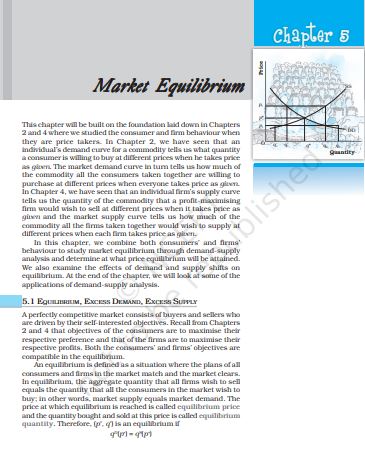‘NCERT Solutions for Class 12 Economics Chapter 5 Market Equilibrium‘ PDF Quick download link is given at the bottom of this article. You can see the PDF demo, size of the PDF, page numbers, and direct download Free PDF of ‘Ncert Class 12 Economics Chapter 5 Exercise Solution’ using the download button.
Market Equilibrium NCERT Textbook With Solutions Book PDF Free Download

Chapter 5: Market Equilibrium
A perfectly competitive market consists of buyers and sellers who are driven by their self-interested objectives.
Recall from Chapters 2 and 4 that the objectives of the consumers are to maximize their respective preferences and that of the firms are to maximize their respective profits. Both the consumers’ and firms’ objectives are compatible in the equilibrium.
Equilibrium is a situation where the plans of all consumers and firms in the market match and the market is clear.
In equilibrium, the aggregate quantity that all firms wish to sell equals the quantity that all the consumers in the market want to buy; in other words, market supply equals market demand.
The price at which equilibrium is reached is called equilibrium price and the quantity bought and sold at this price is called equilibrium quantity.
If at a price, market supply is greater than market demand, we say that there is an excess supply in the market at that price and if market demand exceeds market supply at a price, it is said that excess demand exists in the market at that price.
Therefore, equilibrium in a perfectly competitive market can be defined alternatively as zero excess demand-zero excess supply situation.
Whenever market supply is not equal to market demand, and hence the market is not in equilibrium, there will be a tendency for the price to change. In the next two sections, we will try to understand what drives this change.
Recall that in Chapter 2 we have derived the market demand curve for price-taking consumers, and for price-taking firms, the market supply curve was derived in Chapter 4 under the assumption of a fixed number of firms.
In this section with the help of these two curves, we will look at how supply and demand forces work together to determine where the market will be in equilibrium when the number of firms is fixed.
We will also study how the equilibrium price and quantity change due to shifts in demand and supply curves.
In the above section, we studied market equilibrium under the assumption that tastes and preferences of the consumers, prices of the related commodities, incomes of the consumers, technology, size of the market, prices of the inputs used in production, etc remain constant.
However, with changes in one or more of these factors either the supply or the demand curve or both may shift, thereby affecting the equilibrium price and quantity.
Here, we first develop the general theory which outlines the impact of these shifts on equilibrium and then discuss the impact of changes in some of the above-mentioned factors on equilibrium.
| Author | NCERT |
| Language | English |
| No. of Pages | 17 |
| PDF Size | 1.6 MB |
| Category | Economics |
| Source/Credits | ncert.nic.in |
NCERT Solutions Class 12 Economics Chapter 5 Market Equilibrium
1. Explain market equilibrium.
It is referred to as that state in the market where supply is equal to demand. When a market is at equilibrium, the corresponding price will not change unless there is an external factor that is instrumental in changing the supply or the demand.
Under the condition of market equilibrium, the price at which a product is sold is known as the equilibrium price.
When the market demand for a product/commodity is greater than the market supply, it can be understood that there is an excess demand for that commodity in the market.
When the market supply for a commodity is greater than the market demand, it can be understood that there is an excess supply for that commodity in the market.
In a perfectly competitive market with a fixed number of firms, the price will be determined by the supply and demand that exists in the market. Since the demand and supply will be the same, the price of any commodity will be at equilibrium. This is known as the equilibrium price.
5. What will happen if the price prevailing in the market is (i) above the equilibrium price? (ii) below the equilibrium price?
i) When the price of a product prevailing in the market is above the equilibrium price, supply will be more than demand. Since the product can be sold at a price greater than the equilibrium price, the firm will produce more quantities of the given product and increase the supply. But the demand will be low since the competing firms will also increase their production and supply creating excess supply.
ii) When the price of a product prevailing in the market is below the equilibrium price, supply will be less than the demand. Since the product can only be sold at a price lower than the equilibrium price, the firm will produce fewer quantities of the given product and decrease the supply. The competing firms will also do the same and therefore the supply will not adequately meet the demand creating excess demand.
NCERT Class 12 Economics Textbook Chapter 5 Market Equilibrium With Answer PDF Free Download
